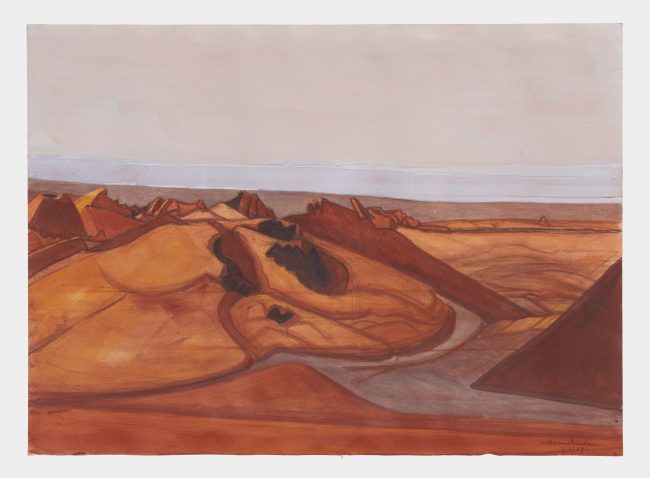A Distant Isle – Wilhelmina Barns-Graham in Lanzarote

Timanfaya Mt. Fuego, 1989, Acrylic on paper, BGT1090
This exhibition at the Belgrave Gallery St Ives marks the thirtieth anniversary of Wilhelmina (Willie) Barns-Graham’s first visit to Lanzarote in 1989. Invited by a friend, she arrived on 23rd February and stayed for three weeks. Staying on the northern half of the island, she travelled extensively around the volcanic region.
Anyone who has been to Lanzarote appreciates what an extraordinary place it is. The island is dominated by substantial volcanic activity, the last eruptions being very recent in geological terms. Willie marvelled at the black rock formations and conic hills, and the strangeness of the lava fields. She was inspired by a world in which the rebirth of the land was a dominant feature. Much of the lava has barely eroded, the surfaces sharp and abrasive. It is not easy to walk amongst it which is why she often drew from the roadside. She made many lava drawings, in its variety of shapes, patterns and textures. Indeed, her fourth trip to Lanzarote (1992) was “confined to lava movement + mostly from one place” where she saw “excellent examples of molten lava, merging + spiral shapes”.
In La Geria, centrally located on the island, the smooth conical shape of the volcanic mounds are offset against the chaotic patterning of the lava. Most drawings are done with pencil though there is a group made with colour crayons and gouaches that reflect “amazing strata bands of grey, red, darkish brown…..”
That Willie visited in the February/March season meant that she saw the island in its fullest colour. Due to the winter rains the landscape becomes alive with colour from the flowers, mainly yellow and purple, that find life in the rich volcanic soil. Greens and browns pepper the hillsides. Farmers grow their produce – vines, fruit and vegetables – in shallow, sunken pits surrounded by protective drystone walls on the lower slopes. However, the geology itself is equally colourful with a palette that ranges from the blue stones of El Golfo to the layers of pinks, reds and oranges of Timanfaya.
Though Willie was primarily attracted to the dramatic volcanic landscape, one other part of the island appealed to her. Orzola is a small community on the top of the island that features salt pans and terraces of small, whitewashed houses with bright green or blue doors and window frames typical of the island. These flashes of colour create a rhythm against the white walls which clearly caught Willie’s eye – her depictions of them remind one of her Orkney collages from a few years before in which spots of colour are arranged against a one-colour background. She made several drawings using colour crayons on black paper as well as small acrylics on board, the latter made when back at her home studios.
How did Lanzarote contribute to her future work? One can see new features in paintings where elements of the landscape have become simplified, moving away from what she described as being “fairly traditional but interesting volcano shapes” into ever increasing abstraction. Furthest removed from the direct experience is a series of very gestural, almost minimalist paintings where the influence is purely one of palette – the reds, blacks and ochres she mentions in her diaries – which can be interpreted as a final evocation of the lava fields.
The visit was a huge success, leading to her making four further visits, the last in 1993. The Lanzarote collection is a remarkable and significant body of work in Willie’s late career, the extent of which is still to be fully assessed. This exhibition sets out some of the island’s influences and encompasses the breadth of what she achieved.
Quotes are taken from Willie’s journals and notebooks.
Belgrave Gallery, 22 Fore Street, St Ives, Cornwall TR26 1HE
Exhibition: 10 to 29 June 2019
Fully illustrated catalogue available from the Trust’s Shop at £8 + p&p
